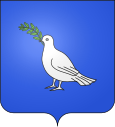Saint-Nicolas-de-la-Grave
| Saint-Nicolas-de-la-Grave | ||
|---|---|---|

|
|
|
| region | Occitania | |
| Department | Tarn-et-Garonne | |
| Arrondissement | Castelsarrasin | |
| Canton | Garonne-Lomagne-Brulhois (main town) | |
| Community association | Terres des Confluences | |
| Coordinates | 44 ° 4 ′ N , 1 ° 1 ′ E | |
| height | 59-88 m | |
| surface | 29.34 km 2 | |
| Residents | 2,260 (January 1, 2017) | |
| Population density | 77 inhabitants / km 2 | |
| Post Code | 82210 | |
| INSEE code | 82169 | |
| Website | www.stnicolasdelag.online.fr | |
Saint-Nicolas-de-la- Grave is a French commune in the department of Tarn-et-Garonne in the region Occitania .
geography
The place with 2260 inhabitants (as of January 1, 2017) is located at the meeting of the historic provinces of Gascony , Guyenne and Quercy . The village dominates the plains of the Garonne and the Sère, framed by orchards and fields . Erected on the left bank of the Garonne - just two kilometers from the mouth of the Tarn - the commune, served by the A62 motorway , is 70 kilometers from Toulouse , 32 kilometers from Agen , 11 kilometers from Castelsarrasin and 8 kilometers from Moissac .
coat of arms
Blazon : "In blue a silver dove with a green olive branch in its beak."
Population development
| 1962 | 1968 | 1975 | 1982 | 1990 | 1999 | 2006 | 2017 |
| 1560 | 1711 | 1722 | 1705 | 2024 | 2099 | 2044 | 2260 |
Attractions
- The rectangular castle (in east-west orientation) Château Richard Cœur de Lion with four corner towers and three wings from the late 11th, 12th and 13th centuries in the north of the village was first mentioned in 1135 in a document between the abbot Wilhelm von Moissac (Guillaume de Moissac), the Vice-Count Saxet of Lomagne and the Vice-Countess Sybille von Auvillar . The north wing is from an older era. The east wing or "English wing" ( l'aile des Anglais ) with the "English tower" ( la tour des Anglais ) on the northeast corner is dedicated to Richard I, the Lionheart of England, who gave the castle its name. He is said to have lived in the castle in Quercy during his campaign in 1185 and initiated the aforementioned extensions. The abbot of Moissac Bertrand von Montaigu and his successors had the west wing with its two towers built between 1260 and 1295. The south side is open, the three wings now form an inner courtyard, the main walls around the castle disappeared in the 19th century. In 1791 the castle became the property of the municipal administration. Today it houses the mayor's office.
- The parish church from 1685 is located near the center of the village and is in the "Toulouse style" with its octagonal vestibule and bell tower. The portal bears elements of the Renaissance . In the church is the tomb of St. Ansbert of Rouen , a legendary abbot of Moissac .
- The chapel Notre Dame de Pitié or Notre- Dame des Sept Douleurs (Chapel "The Seven Sorrows of Mary" ) replaced its previous building in 1836, which was destroyed in the turmoil of the revolution in 1793. It was a well-known place of pilgrimage for sailors.
- The Lamothe-Cadillac-Museum ( Le musée Lamothe-Cadillac ) is dedicated to the life of the adventurer Antoine Laumet .
Personalities
- Antoine Laumet de La Mothe, Sieur de Cadillac (1658–1730), French officer and politician, founder of Detroit and governor of Louisiana .
- Thomas Goulard (1697–1784), French surgeon , grandfather of Marc-Eugène de Goulard
Web links
Commons : Saint-Nicolas-de-la-Grave - Collection of images, videos and audio files

